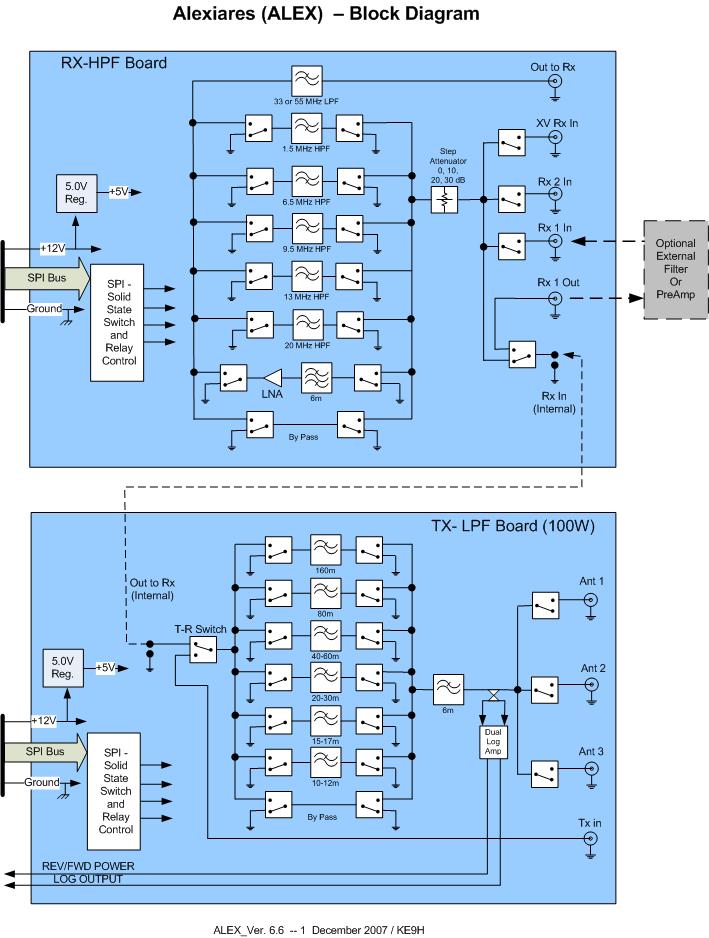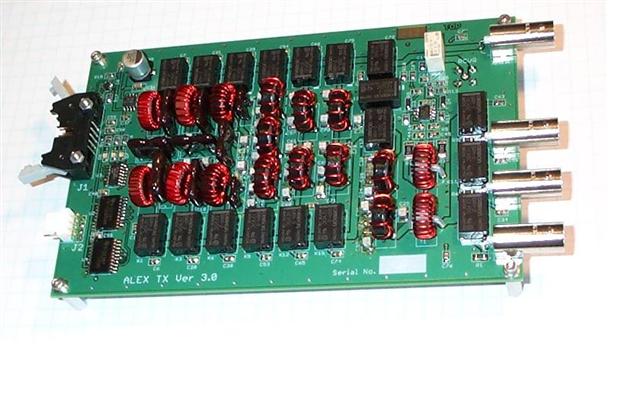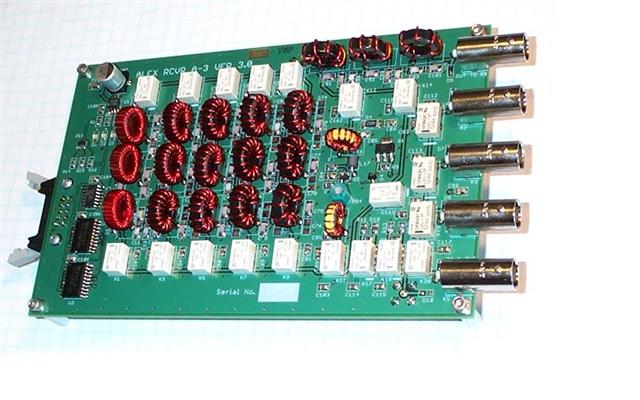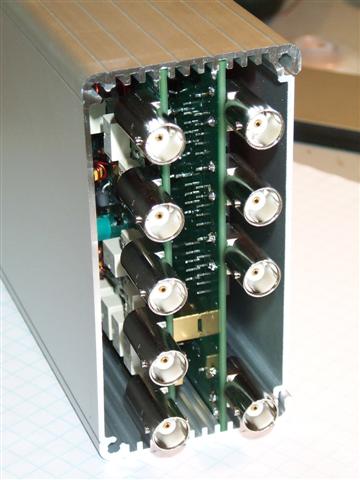ALEXIARES
ALEXIARES (or ALEX for short) is a combination RF Preselector for use with Mercury or any other SDR, as well as a transmitter low pass filter bank for a transmitter such as Penelope, and optionally, with an associated RF power amplifier up to 100 watts peak.
The project leader for ALEX is Graham, KE9H, who is also laying out the PCBs. Design work is being shared between Graham and Phil, VK6APH.
As a receiver preselector, the purpose of ALEX is to reduce the level of out-of-band signals at the input of a receiver, and importantly, to suppress any signals at the sampling image or alias frequencies. See Anie for ideas on a tunable preselector.
As a transmitter low pass filter, ALEX will suppress the harmonic energy typically generated by an RF power amplifier, as well as the images or aliases that appear at the sampling clock frequency (122.8 MHz) plus/minus the operating frequency. The transmit low pass filters will also be used for additional MERCURY receiver input band limiting.
You will normally "pair" one of the low pass filters on the transmit board with one of the high pass filters on the receiver board. There is an additional 33 or 55 MHz low pass filter on the receiver board, plus the 6 Meter transmit low pass filter that are in-line at all times to help suppress VHF images.
Contents
PRESELECTOR ISSUES WITH DATA CONVERTERS
There are at least three major issues to consider with a preselector for a data converter type receiver such as MERCURY.
- First is protecting the receiver from overload. The data converter in MERCURY is a highly linear and robust converter, but it does have limits. The maximum input level that the converter can accept before degrading overall performance is 1.5 volts peak to peak, or +8 dBm which is S9 plus 81 dB. This is AFTER any gain that appears between the antenna and the data converter. A local broadcast transmitter or nearby amateur transmitter might generate this kind of level. This is the traditional purpose of a preselector, to lower the level of out of band emissions. They do not need to be eliminated, just reduced so that the data converter is not overloaded.
- Second is linearity. The native linearity of the data converter is excellent, something on the order of an IP3 of +50 dBm. So high that it is difficult to measure with traditional test equipment, and so high that the non-linearity of the toroid inductors or electronic switches can limit receiver performance. You don't normally expect switches or inductors to be "non-linear," but at these levels, they can be. The IP3 of the overall receiver will typically be lower than the +50 dBm of the data converter by any preamplifier gain (typically 10 or 20 dB with MERCURY).
- Third is image suppression. The MERCURY receiver uses a sampling frequency of 122.88 MHz for the analog to digital data converter. This means that the MERCURY receiver will directly sample signals in the 0 to 61 MHz band, but signals above those frequencies can also appear in the data converter output. For example, assume that a signal at 10 MHz is to be monitored by Mercury. A signal at 122.88 MHz plus 10 MHz and a signal at 122.88 MHz minus 10 MHz will also appear to be at 10 MHz as "images," unless they are prevented from getting to the input of the data converter. Those are just examples. Of more concern are the VHF TV and FM signals that will "fold" back into the HF and 6 Meter receiver band if not eliminated. The 88 to 108 MHz FM band could appear as images at 15 to 35 MHz. US TV Channel 4 audio subcarrier at 71.75 MHz will fold back to 51.13 MHz. The data converter has NO native selectivity or rejection at the image frequencies, so the total system selectivity of the antenna system, matching networks and preselector frequency rejection must add up to something on the order of 120 to 140 dB, depending on how strong the TV and FM signals are in your area. This also has implications for requirements for some shielding contribution from the overall housing and some shielding of the ALEX filters themselves.
There is a similar issue with the Penelope transmitter. In addition to the desired HF signal at the operating frequency, the D->A converter also puts out images or aliases at the sampling frequency (122.8 MHz) plus or minus the operating frequency. This means that "flyback" in the stopband of a transmit harmonic filter in the 90 to 160 MHz range that might not be a problem in a traditional HF transmitter must be addressed in ALEX.
DESIGN GUIDELINES
The primary purpose of ALEX is to be a preselector for MERCURY, and should not materially degrade MERCURY's native performance. There should not be any restrictions that would prevent ALEX from being used with any other receiver that required a similar preselector.
MERCURY is an extremely robust receiver in its native performance.
Measured MERCURY Prototype Specs:
MERCURY with no net preamplification. -
Noise figure 27 dB
IP3 +50 dBm
Max signal +8 dBm (S9 + 81 dB) (Total of all signals)
MERCURY with 10 dB net preamplification - [Typically 1.8 to 13 MHz.]
Noise figure 17 dB
IP3 +40 dBm
Max signal -2 dBm (S9 + 71 dB) (Total of all signals)
MERCURY with 20 dB net preamplification - [Typically above 13 MHz.]
Noise figure 7 dB
IP3 +30 dBm
Max signal -12 dBm (S9 + 61 dB) (Total of all signals)
Note: The MERCURY A->D converter will likely be configured with an (always on)
+20 dB gain preamplifier, which drives the input of the data converter. The above
represent (ALEX or external) attenuator settings of 20 dB, 10 dB and zero, respectively.
DESCRIPTION
ALEX consists of two Euroboard sized PC boards (10 cm by 16 cm). They are intended to be mounted in a commercial Euroboard extruded aluminum housing. The target commercial housing is a Hammond 1455N1601 extruded aluminum case (or equivalent.) ALEX does not plug into the ATLAS bus, but is intended for separate mounting, and is controlled by an SPI bus. There are nine BNC connectors that will extend through to the outside of the filter or HPSDR housing, for external access.
The first PC board is the Receiver/HPF board. It has a 33 or 55 MHz 7th order Low Pass Filter that is always in line with the receiver. If the user is going to operate on 6 meters, the 55 MHz version should be used, otherwise, the 33 MHz version is recommended (for better VHF image suppression.)
There is a 6 meter low noise preamp; selectable 20 MHz, 13 MHz, 9.5 MHz, 6.5 MHz and 1.6 MHz high pass filters, plus a bypass function. It has five external BNC connectors, described below.
The receiver board also contains a switchable front end attenuator, configurable for 0 dB, 10 dB, 20 dB or 30 dB loss.
The second PC board is the Transmitter/LPF board. It consists of seven relay switched low pass filters for transmitter harmonic suppression, that are also used in conjunction with the receiver high pass filters to provide a flexible variable bandwidth receiver input filter function. It has four external BNC connectors, described below.
Each active board contains three LEDs, so that an indication of power and proper control and SPI bus operation can be seen.
ALEX is controlled by an SPI bus. This SPI bus should NOT be shared with other devices, in that it is intended that the data and clock lines should not be transitioning except when a command is being sent to one of the ALEX boards. There are two analog voltage outputs providing an indication of transmit forward and reverse power. There are no oscillators or continuously running clocks anywhere inside of ALEX.
Specifications:
On frequency insertion loss - variable according to frequency, but typically will not exceed 2.0 dB total for receive paths, and 0.5 dB for transmit paths.
Power handling capability - The transmit harmonic filter banks and associated relay switches are intended to handle up to 100 watts, peak power with a CW or SSB duty cycle.
Contribution to Receiver IP3 performance - Measured in the Alpha versions as approximately +50 dBm. That is, there is no measurable degradation of native Mercury IP3 performance.
Total power consumption for ALEX can vary over a range of 90 to 180 mA., all from the +12 volt supply. 90 mA is with 12.0 Volt supply, minimum number of relays active. 180 mA is with 13.8 Volt supply, 50 MHz transmit, 50 MHz preamp. on, all LEDs on, and both receive attenuators active. The +5 Volt and -12 Volt supplies are not used.
- External Connections -
- Receiver Board - five ea. BNC female connectors to extend through the case.
- Receiver Out (to MERCURY input)
- Transverter Input (receive only) (The output to the transverter is on PENELOPE)
- Receiver AUX input 1 (receive only)
- Receiver AUX Input 2 (receive only)
- RX AUX Output (for looping in an external filter or preamp)
- Receiver Board - five ea. BNC female connectors to extend through the case.
- Transmit Board - four ea. BNC female connectors to extend through the case.
- Antenna 1 (transmit-receive)
- Antenna 2 (transmit-receive)
- Antenna 3 (transmit-receive)
- Transmitter In (From PENELOPE or associated RF PA)
- Transmit Board - four ea. BNC female connectors to extend through the case.
- Internal RF connections -
- Receiver Board - one SMB female connector
- Internal receive input from Transmitter card
- Transmit Board - one SMB female connector
- Internal receive output to the Receiver board
- Receiver Board - one SMB female connector
- Control - 10 pin polarized ribbon cable connector
- +12V, GND, SPI Data, SPI Clk, SPI LoadRX, SPI LoadTX, Forward PWR, Reverse PWR.
- Note: All receiver inputs that could be expected to be connected to an antenna will have voltage transient protection.
TESTING RESULTS
Thanks to John, N8UR, for testing and documenting the performance of the ALEX filters. This is ongoing testing in preparation for manufacturing, and the latest results can be viewed on his website at http://www.febo.com/pages/alex.
Bill, KD5TFD, has built and tested one of the Alpha-3 filter sets. See http://tracey.org/wjt/hpsdr/Alex/sa0630/
CURRENT STATUS
August 3, 2008 - The production release information package for ALEX has been sent to TAPR for review and approval.
June 28, 2008 - Phil did show Alex, along with Mercury and Penelope at Dayton. Three sets of Alpha-3 boards are built and in test. A few "tweaks" to capacitor values have been made, and the design is getting close to being frozen.
April 26, 2008 - Phil, VK6APH reports having finished building a set of Alpha-3 PC boards. Testing should start soon, and hopefully will be demonstrated at Dayton with a Mercury-Penelope receiver-transmitter.
March 14, 2008 - Alpha-2 boards were laid out, and one set built up for measurements. All of the Hittite switches in the Alpha-1 design were replaced by relays on the receiver board. The transmitter board was already using relays due to the 100 watt power levels. All changes look good. There is one nagging problem with PCB parasitics detuning the 6 Meter transmit Low Pass Filter, but an alternate filter design recognizing the board parasitics should resolve the problem. TAPR manufacturing has requested a change to a mass termination (ribbon cable) control cable and connector to lower costs and eliminate the board to board control jumper, so there will be an Alpha-3 version of the boards before we go final. Phil has been using the Alpha-1 version continuously for Mercury-Penelope testing, including on-the-air contacts, and has not found any new problems.
December 11, 2007 - Phil has completed the evaluation of the Alpha version of the ALEX receiver board. The main issue is that the losses of the Hittite solid state switches are too high for them to be used in most locations, so we will go back to relays for much of the 50 Ohm switching. A few other tweaks are necessary for packaging reasons, so the Alpha-2 version layout is underway. Using this high-pass/low-pass switchable filter approach results in no measurable degradation to the IP3 performance of Mercury.
November 11, 2007 - The Alpha-1 version of the ALEX receiver board is built and ready to start testing. A picture has been posted on the Wiki page. Phil, VK6APH has completed testing of the ALEX transmitter board, and reports good results for the directional coupler, no measurable degradation of receive IP3, and that the LP filters work well at 100 watts with SSB and CW duty cycles.
October 8, 2007 - The Alpha-1 version of the ALEX transmitter filter board is complete, through initial testing and a unit shipped to Phil, VK6APH for further evaluation. The companion receiver filter is in layout. Pictures of the board and the proposed housing have been added to the Wiki page.
August 5, 2007 - After the call for comments, changes and revisions to the ALEX concept and description have been incorporated into the Wiki page.
July 24, 2007 - Phil, VK6APH released measured performance for prototype MERCURY in an email to the group dated June 18. A preliminary design for ALEX is being released for review and comment before first pass PC board layouts are completed. The information released for comment on July 24 is at revision level 6-2.
WHY ALEXIARES?
Alexiares and his twin brother Anicetus - were the Greek Gods of Defense, in particular the defense of fortified towns and citadels.
Both were sons of Hercules (Herakles), born after the Hercules' ascension to Olympus and his marriage to the goddess Hebe. Alexiares and Anicetus helped serve as the gatekeepers of Olympus, assisting their father in a role which was commonly assigned to him.
RELATED DOCUMENTS AND LINKS
- The Schematics and Bill of Materials are in this ".pdf" file. Media:ALEX_P1_Binder.pdf
- Hammond Euroboard Instrument Case: Mouser # 546-1455N1601, or Hammond # 1455N1601
- The PCB cards and schematics are being designed in EAGLE Layout Editor: http://www.cadsoftusa.com/ and http://www.cadsoft.de/
- The original design of these filters were done in ELSIE. Jim Tonne, WB6BLD, Tonne Software, just revised his product offering. I would recommend his "Pro-Lite" version as the minimum version to implement or modify one of the filters. This is a good tool for this kind of filter design. http://tonnesoftware.com/elsie.html




